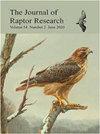驱动朱迪亚地区长耳猫头鹰(Asio otus)种群增长和生产力的栖息地因素
IF 1.2
4区 生物学
Q2 ORNITHOLOGY
引用次数: 0
摘要
在以色列,长耳猫头鹰(Asio otus)被认为主要是一种越冬物种,只有零星的繁殖记录。然而,到了上世纪末,长耳鸮在以色列北部和中部地区的繁殖数量越来越多。根据对朱迪亚地区巢穴数量的分析,我们确定在 2003 年至 2008 年期间,朱迪亚的种群数量每年至少增加 22%,从 2003 年的 28 个已知巢穴增加到 2008 年的 118 个。我们认为,我们的研究是在该地区长耳鸮种群扩张的最初几年进行的。我们发现,在城市地区筑巢的鸟类比在农村地区筑巢的鸟类每窝产下的后代要少。我们还发现,在夜间人工光照下,城市地区的雏鸟比野外地区的雏鸟更早羽化。朱迪亚地区长耳鸮筑巢数量的快速增长可能至少部分归因于该物种对城市地区的适应。本文章由计算机程序翻译,如有差异,请以英文原文为准。
Habitat Factors Driving Long-eared Owl (Asio otus) Population Growth and Productivity in the Judea Region
In Israel, Long-eared Owls (Asio otus) were considered primarily a wintering species with documented sporadic breeding. However, by the turn of the last century, it had become an increasingly numerous breeding species in the northern and central parts of the country. Based on the analysis of nest numbers in the Judea region, we determined that the population increased by at least 22% each year between 2003 and 2008, from 28 known nests in 2003 to 118 in 2008. We believe our study was conducted during the initial years for the Long-eared Owl population expansion in the region. We found that birds nesting in more-urban areas produced fewer offspring per brood than birds in more rural areas. We also found that nestlings from more-urban areas, exposed to artificial light at night, fledged earlier than birds from wild areas. The rapid growth in the numbers of nesting Long-eared Owls in the Judea region was likely due, at least in part, to the species’ adaptation to urban areas.
求助全文
通过发布文献求助,成功后即可免费获取论文全文。
去求助
来源期刊

Journal of Raptor Research
生物-鸟类学
CiteScore
2.30
自引率
17.60%
发文量
61
审稿时长
>12 weeks
期刊介绍:
The Journal of Raptor Research (JRR) is an international scientific journal dedicated entirely to the dissemination of information about birds of prey. Established in 1967, JRR has published peer-reviewed research on raptor ecology, behavior, life history, conservation, and techniques. JRR is available quarterly to members in electronic and paper format.
 求助内容:
求助内容: 应助结果提醒方式:
应助结果提醒方式:


